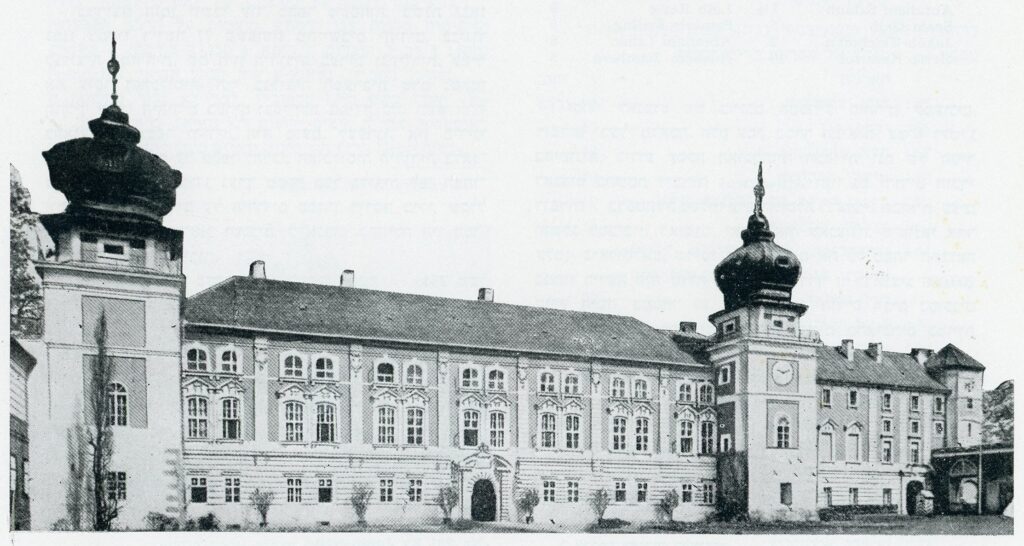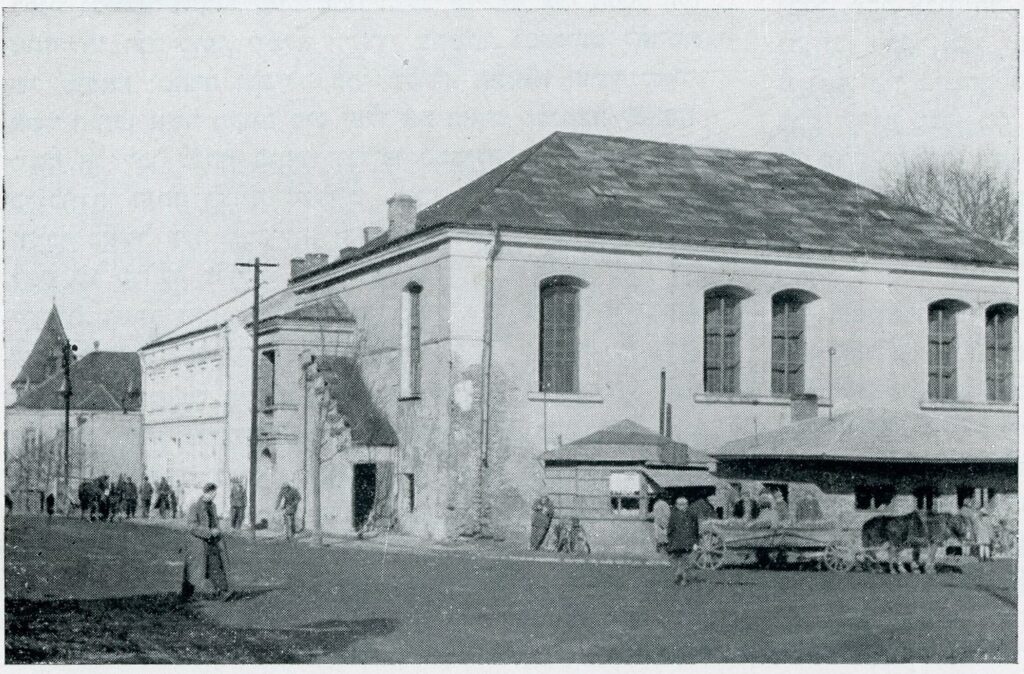Count Potocki and the Jews of Lancut

Count Potocki’s castle in Lancut
Jews lived in Lancut for four hundred years. According to the records of the Polin Museum, Rebbe Elimelech of Lezhansk lived in Lancut for about two years after the end of his (self-imposed) exile, and from there he moved to Lezhansk with his students. It also appears there that in 5546 (1785-6), Rebbe Elimelech’s last year of life, during the Austrian rule over the region, the Lezhansk community submitted a request to the authorities for the allocation of land for the establishment of a Jewish settlement of 70 families in the vicinity of Lancut. The initiative was unsuccessful, as the Austrian government gave approval of sparse and remote land.
Lancut became a vibrant economic center with the opening of a railway line and the expansion of the beverage and sugar factories by the Potocki family – the owners of Lancut. The town’s population soon began to grow. In the mid-19th century, there were about 20 Jewish-owned inns in the town. The Jewish population in the town grew steadily, and by 1900 it had reached 1,940 people (40% of the population). Jews played an increasingly significant role in the town’s life, and were socially and politically active.
In 1921, the city had 4,518 residents, of whom 1,925 were Jews. In 1910, the Jewish community built a new and impressive mikvah (ritual bath).

Appearing in the photo is Righteous Among the Nations, Count Alfred Potocki
Craft and trade were the main source of livelihood for the Jews of Lancut. Two-thirds of the 250 local shops and stalls were owned by Jews. There were two Jewish banks in the town, as well as the People’s Bank with 301 shareholders in 1932 and the Bank of Artisans and Farmers, which had 916 shareholders.
When World War II broke out, Lancut had a population of 2,735 Jews. On September 22nd, 1939, some of them were deported to the Soviet occupation zone across the Seine.
Few Jews survived from Lancut, but the glory of Lancut, its magnificent synagogue, stands tall and is a testament to the Jewish life that flourished in this town for centuries.
Before we visit the ancient and spectacular synagogue in Lancut, which is a magnificent architectural gem and attracts tourists and visitors, we will tell you a little about Count Alfred Potocki, a Polish nobleman who loved Jews and protected the synagogue from demolition, even though he could have paid for this act with his life.
If the survivors from Lancut were still alive, we would recognize a spark of excitement on their faces at the mention of Count Potocki, because his image was woven into the routine of Lancut and its way of life, and unlike other nobles and counts of Polish cities and towns, he left behind a pleasant trail of memories and longing. He was a decent gentile, and at the end of his days he received institutional appreciation for his actions as a “Righteous Among the Nations.”
Visitors to Potocki’s magnificent palace in Lancut said that one of the most spectacular displays in it is the magnificent menorah that the Count received from the Jewish community as a token of appreciation. Alfred, was referred to by the Christians as the “Uncle of the Jews.” A large part of the town’s Jews made a living from him, and not only that: he used to eat only kosher meat, because he did not want to replace the meat sellers Chava and Shifra Scheinmann, the Jews who provided him with meat and fish at home.
There is much to tell about Alfred and in general about the noble lineage from which he sprang, but within our limitations we will tell about what concerns Count Potocki’s relations with the Jews before and during the war.
In their memories, the survivors from Lancut always interwove stories and anecdotes about the count and his relations with everyone. He was interested in their livelihood, their dreams, their initiatives and their personal lives. So, in the period between the two wars, when many of the residents of Lancut dreamed of immigrating to Israel and participated in training kibbutzim, the count would accompany the young people with advice and action and never ceased to be interested in their fate after they left the town and settled in Israel.

The great synagogue of Lancut with the beit midrash (study hall) next to it
In 5637 (1937), when the Polish boycott of Jews and their businesses took place, they tried to enlist Lancut and the count in the boycott initiative, but Alfred Potocki firmly refused. Lancut’s Jews were his friends. He would take an interest in their affairs and lend a helping hand when needed. He especially acquired a liking for Moshe Shtitzel, a violinist who was born on the same day as the count.
Many of the descendants of Lancut remembered Ephraim Goldman well; he was known as “crazy,” but his talents were rare. He would recite rhymes, sing, sculpt, and paint. The count would often invite Ephraim to balls he held in his palace. The appearance of the Jew dressed in chassidic clothing would catch the attention of the guests. Among his unique talents, which he would present to the distinguished guests: he would sketch the figures of people on the wall in a matter of moments. (According to the record in the Yad Vashem Page of Testimony, Ephraim son of Rabbi Menachem Mendel – may G-d avenge his blood – was burned to death in 5702 [1941-2] in the synagogue in Kutzin.)
In Elul 5699 (Sept. 1939), in the early days of the Nazi occupation, Alfred participated in a town hall meeting on the subject of the deportation of the “traitorous” Jews. He firmly refused the idea and took upon himself the responsibility that the Jews would not be traitors. During the first days and weeks of the Nazi occupation, in the shadow of the decrees, the killings, the vandalism and the humiliation, Alfred Potocki revealed his kindness and often risked himself to protect Jews and their property.
On the eve of the Sukkot holiday of 5700 (1939), the Nazis gathered all the Jewish residents in the Strosta Garden. This was done amidst beatings and humiliation. On their way, two Jewish women (Kestin and Wolkenfeld) met Potocki on his way to the city council meeting. He was pained and moved and whispered to them: “Carry your fate with pride and preserve your honour.” After the city council meeting, a large Jewish delegation came to him. The count told them: “I did everything I could, but I succeeded in nothing.”
At that moment, his eyes welled up with tears and he said to his visitors: “I advise you to flee. Flee wherever your eyes take you.”
During the war years, the Jews were expelled from places, and refugees frequently came to the city, and at all times Potocki’s hands were open to offer help and assistance. He donated money and supplies, he provided coal, and thanks to his support, soup kitchens were established in difficult times.
In the year 5702 (1942) the count’s workers were arrested and accused of belonging to an underground organization. The underground printing house built in the palace under the roof incriminated them, and the count himself was also interrogated at the Gestapo offices.
During World War II, the Nazis set fire to the historic synagogue in Lancut. According to witnesses, the synagogue furniture was piled in the center of the hall and began to burn, but the fire was suddenly extinguished by German officers who arrived quickly on orders from above, thanks to the intervention of Potocki, whose palace housed the Nazi headquarters. This intervention saved the historic synagogue from destruction.
A photo gallery of the synagogue and the room of the Maggid of Kozienice (Rabbi Yisrael Hopstein), and more details about the synagogues in Lancut will be shared in the next chapter, G-d willing.














